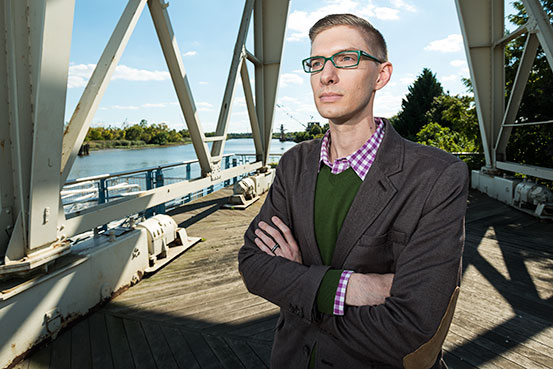



By beth chajes Delaware Environmental Institute

The inability of the international community to agree or stick to a plan for limiting global climate change leaves local communities in a quandary — what must they do to adapt if at least some level of climate disruption is inevitable?
As Dale Jamieson, director of the environmental studies program at New York University, writes in the 2010 book Climate Ethics: Essential Readings, “the challenge of climate change is not only global and abstract but also local and intimate.”
Kevin Adkin, a doctoral candidate in UD’s School of Public Policy and Administration, who is advised by Yda Schreuder of the Department of Geography, believes the time is right for climate science and ethics to coalesce and provide some guidance for those local leaders left to make decisions on behalf of their communities.
In his recent doctoral dissertation, Adkin asserts that while many communities at both the state and local levels are already beginning to adapt to climate change, they often lack a solid ethical framework on which to base their policy decisions.
In practice, formulating such policy often comes down to determining how to spend limited resources: Who should receive financial help or compensation? In many ways, the problem parallels the classic ethical conundrum commonly known as “lifeboat ethics.” If the resources provided by a lifeboat already occupied by 10 people are only capable of supporting 15, who among the 20 people still in the water will be rescued?
State and local officials in Delaware view sea level rise as the most formidable climate challenge facing the state, which averages just 60 feet above sea level. In a recently released vulnerability assessment report, the Delaware Department of Natural Resources and Environmental Control estimates that between 8 and 11 percent of the state’s land area could be inundated by sea level rise by 2100, and 31 of the state’s 57 municipalities will be directly impacted.
“Although the direct impacts from sea level rise will be felt primarily in areas near tidal waters,” the report states, “every Delawarean is likely to be affected whether through increased costs of maintaining public infrastructure, decreased tax base, loss of recreational opportunities or loss of community character.”
In his research, Adkin focused on the neighborhoods of South Wilmington, Del. Situated on the edge of the Delaware River, South Wilmington is a particularly low-lying area that already experiences frequent street flooding during heavy rains.
Adkin characterizes South Wilmington as a community facing many difficult challenges. With its high percentage of low-income and minority residents, South Wilmington often faces more immediate concerns, such as lack of economic opportunities or crime.
“Industrial brownfields pervade the landscape in South Wilmington,” he says, “but people in the vicinity don’t always make the connection between the brownfields and their economic and health conditions. They have more pressing concerns.”
However, the presence of contaminants, sequestered in the soil of abandoned industrial sites in South Wilmington, could greatly complicate the decisions of community leaders as they struggle to plan for sea level rise.
Scientific studies to analyze what will happen to these contaminants, which range from heavy metals such as arsenic to organic compounds such as PCBs, when they come into contact with sea water are just getting under way at the University of Delaware.
“This is a new area that hasn’t yet been studied,” says Donald L. Sparks, an environmental soil chemist involved in the research and director of the Delaware Environmental Institute at UD. “We know something about the interactions of soil contaminants with freshwater, but the addition of salt from seawater inundation could significantly change the behavior of these toxins.”
If it turns out that sea water mobilizes contaminants and makes them more available for absorption by living organisms, the adverse health impacts on nearby residents could be significant.
Regardless of the outcome of such studies, Adkin says his work will help community, city and state leaders deal with the consequences of sea level rise in South Wilmington and other vulnerable communities in Delaware. He will be submitting his recommendations in reports to the Delaware General Assembly and the Wilmington City Council.
Questions will inevitably arise, he says, as to whether we have more responsibility to disadvantaged populations or to areas with higher property values or where the tax base is greater.
“My aim is not to prescribe solutions,” says Adkin. “Rather I have summarized the ethical principles involved to make climate change policies as equitable as possible. The more equitable our policies are, the less disagreement and animosity we will encounter as a society.”